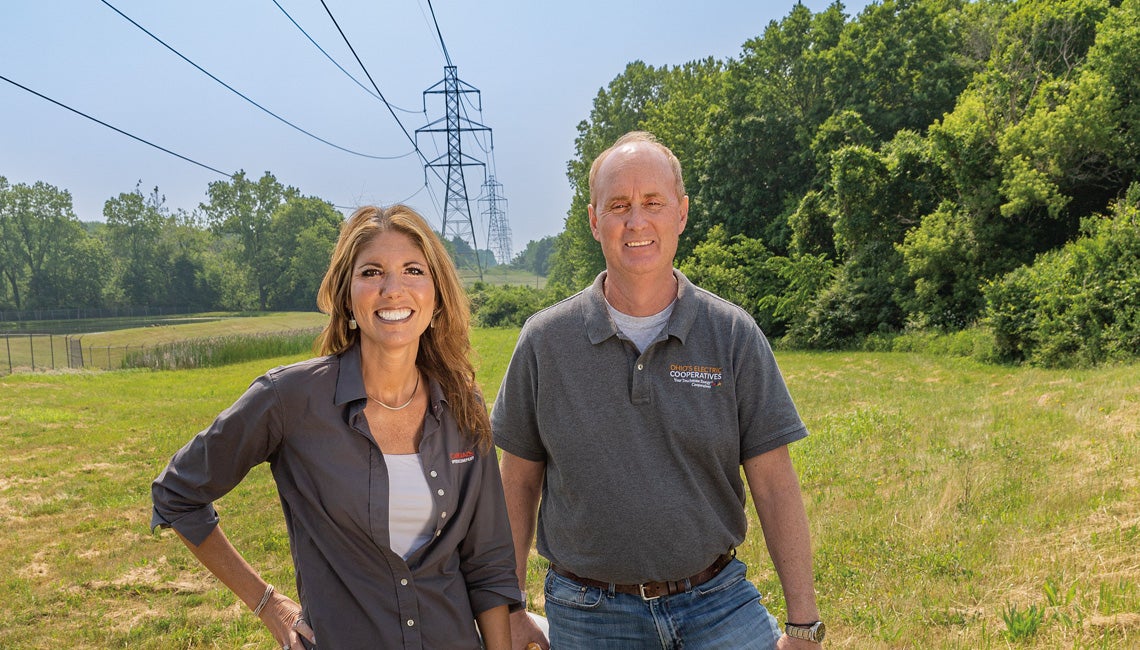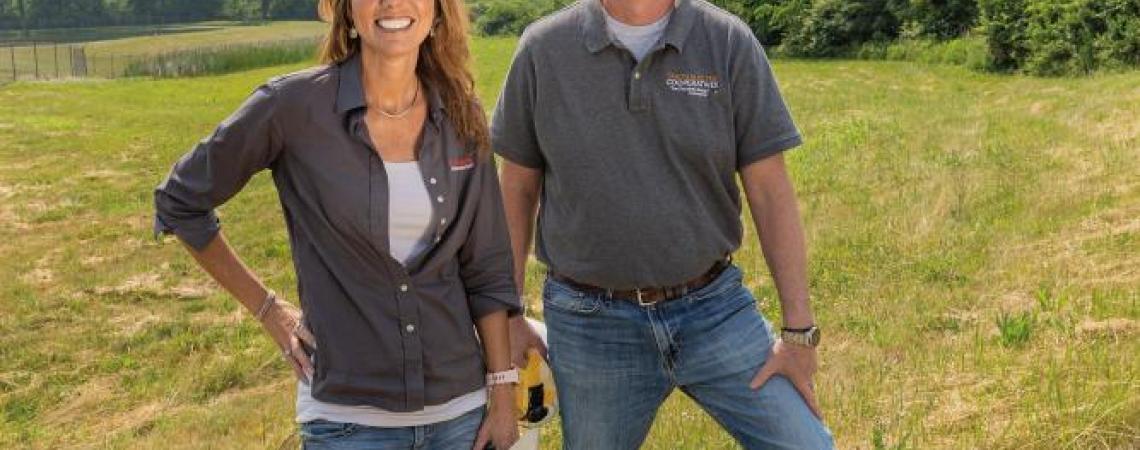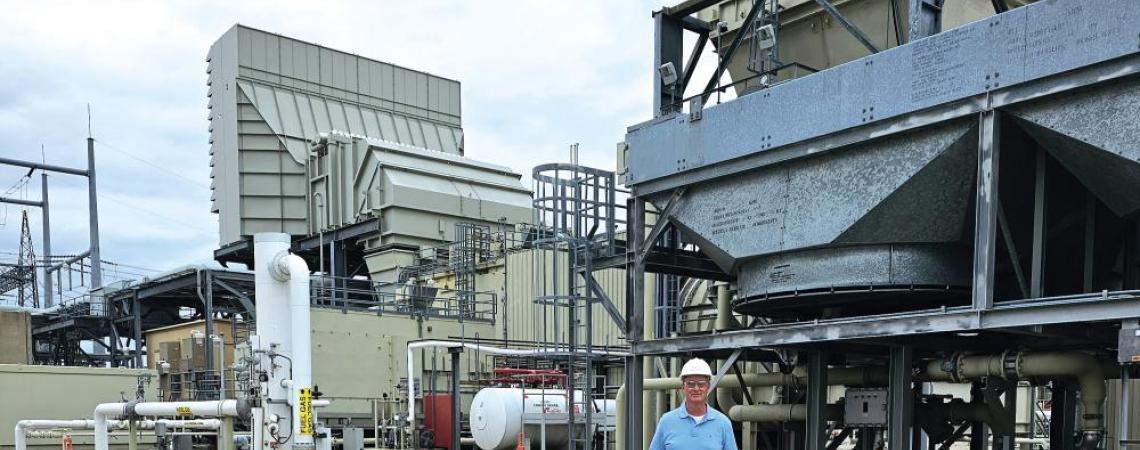Electric power is a service that is simultaneously deeply appreciated and yet taken for granted. We may feel a general sense of safety and comfort when the kitchen lights brighten a dark winter morning, when we feel the relief of an air-conditioned room on a sweltering summer afternoon, or when a shopkeeper switches on the security system at the end of the workday.
It’s rare, though, that we give a thought to the source of that sense of well-being, and that’s an irony that David Richardson and Bethany Schunn have come to accept.
From opposite sides of Ohio, Schunn and Richardson manage the power plants that provide most of the electricity to the 25 electric distribution cooperatives served by Buckeye Power. About 1 million Ohioans depend on the reliable, affordable power they send to about 400,000 homes, farms, and businesses.
Plant manager Bethany Schunn watches over the Cardinal Plant on the bank of the Ohio River near Brilliant.
Powering Ohio’s co-ops
“We all take electricity for granted, until you’re at your own house and you lose it, and then you say, ‘Where’s the power company?’” laughs Schunn, plant manager for the Cardinal Power Plant in Brilliant, a small town on the Ohio River in eastern Ohio. Cardinal’s three coal-burning units produce up to 1,800 megawatts of power at a given moment. It’s the main baseload generating plant for Buckeye Power.
About 250 miles to the west (and about 70 miles from one another), the Robert P. Mone Plant in Convoy and the Greenville Generating Station in Greenville are managed by Richardson. These natural-gas-burning facilities are “peaking plants” — fired up during periods of particularly high demand, or when other sources go offline.
The baseload plant and the “peakers” are vastly different in terms of how, when, and why they produce power. Their managers, likewise, have taken much different career paths to get to their current positions. Neither, however, considered the energy business as a career, starting out.
An unforeseen path
Schunn, 41, is originally from Wheeling, West Virginia, where her mother was in banking and her father was the sports editor at the local paper.
She planned to be a pharmacist, but after getting an undergraduate degree in chemistry, she began working as a laboratory chemist. That, in turn, led to a job at American Electric Power’s Conesville Power Plant near Coshocton. After working in the lab there for a while, she took over supervision of the equipment that removes sulfur dioxide from the plant’s emissions.
Along the way, she married, picked up a master’s degree in business, and had three children.
“I never thought, when I was in school, that I would work at a power plant, let alone make it a career,” she says. “I didn’t even know they had a lab in a power plant. But it’s been so rewarding. You learn the process and you learn how you help people.”
After a dozen years with AEP, she had risen to the position of maintenance superintendent at Conesville when Buckeye Power hired her in 2017.
Buckeye takes charge
AEP and Buckeye Power had always had a unique — and beneficial — relationship at Cardinal: The investor-owned AEP and member-owned Buckeye had split ownership of the units since the plant opened in 1967, and AEP, using its long history and expertise, operated the units on behalf of both entities from the beginning.
When AEP decided to abandon its generation business in Ohio, Buckeye Power agreed to take over operations and hired Schunn to help manage the transition. (Buckeye Power also bought AEP’s remaining stake in the generating units in 2022.) A few months after the transition was completed in March 2018, Schunn was promoted to plant manager when former manager Chuck George retired.
With nearly 300 employees and power production happening 24 hours a day, seven days a week, Cardinal is a bustling industrial megalopolis on the banks of the Ohio River. About 25 trucks and eight river barges arrive daily, delivering the roughly 15,000 tons of Ohio, Pennsylvania, and West Virginia coal the plant typically burns over a 24-hour period. More trucks carry away the fly ash that’s produced as the coal burns, to be sold and made into concrete; and gypsum, a byproduct of the flue-gas desulphurization scrubbers, is loaded onto barges and taken away to produce wallboard.
Life at the peakers
That hustle and bustle is in sharp contrast to the peaker plants, which get their fuel delivered by underground gas lines, so few trucks go in and out. Also, unlike Cardinal, the Mone and Greenville plants typically don’t run 24/7, and instead are on constant standby to add power to the grid on a moment’s notice when the need arises. Their turbines are designed to be started quickly — in a matter of minutes — as soon as that call comes in, Richardson says. Between them, the two gas-fired plants host a total of seven generating units and, combined, can produce up to 710 megawatts of electricity.
And they’re not as labor-intensive as a coal plant, either. Each peaking facility operates with a small staff of technicians who rotate their shifts between morning and evening. “Everything is automated here,” Richardson says. “Once we get the call to run and hit the start button, we can hit our max load of 50 to 60 megawatts per unit at Greenville in 15 minutes; at Mone, we can go from zero to 150 or 180 megawatts on each unit in less than 30 minutes.”
Though the peakers operate as needed, that does not mean “rarely.” The plants are in use between 100 and 150 days of the year, and sometimes, they are fired up several times in one day. When the turbines are not spinning, the small staff is maintaining the plant, keeping the units in top condition to be always at the ready.
Richardson and the teams at the peaker plants recognize that their power is often needed at unplanned and inconvenient times, and they take it in stride. “I’ve heard the guys say it: We’re like the fire department,” Richardson says. “We get called on when there’s an emergency, or when it’s extremely cold or extremely hot, and we know that if we can’t run, we’ll be hurting people. We all have that in the back of our heads.”
Long and winding road
Richardson, 59, is a first-generation college graduate who lives just across the border in Indiana, with his wife of 37 years (the couple has two grown children). After earning an engineering degree from Purdue University, he worked in construction, in the petrochemical industry, and for other utilities before landing at Dayton Power & Light (now AES Ohio), which operated the Greenville plant at the time.
His path to Buckeye Power, not unlike Schunn’s, involved the transfer of ownership and operation, in this case from DP&L to AEP and, in 2018, to Buckeye. Having worked for investor-owned utilities, merchant plants, and electric cooperatives, Richardson says he prefers the co-op model.
“In an investor-owned utility, the CEO’s main job is to keep the stock price high and the investors happy,” he says. “At Buckeye, it’s all about the co-ops and their members. Our goals are to focus on safety, reliability, and affordability and to make sure our operations are environmentally sound.”
An awesome responsibility
Both managers understand customers don’t think much about their electric power until something goes wrong — but that only increases their sense of mission and their pride in the teams they lead.
Last December, as many co-op families prepared for the holidays, a “bomb cyclone” hit much of the eastern U.S., bringing sub-zero cold and howling winds on Christmas Eve. As the deadly storm approached, PJM Interconnection (the regional transmission organization that coordinates grid reliability) called for every generating station in the system “to come online and provide as much output as they could,” Schunn recalls.
As Ohioans battened down the hatches and bundled up, the crews at Cardinal, Mone, and Greenville went into overdrive. “We ran 24/7 at both plants for at least a week,” Richardson says. “Nobody spent Christmas at home, that’s for sure.”
Schunn credits early seasonal winterization efforts by workers at Cardinal for the fact that the plant was able to operate at full capacity throughout the weather emergency. “I was very proud of our team. First of all, it’s Christmas. No one wants to be working. And it’s cold as hell. But we were one of the very few plants (in the 13-state PJM network) that didn’t go offline or experience curtailments.
“That Christmas, they really needed us, and we were able to provide,” she says. “I’m really proud of that.”












